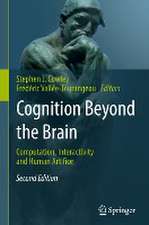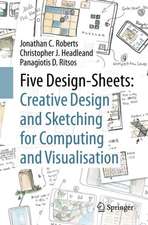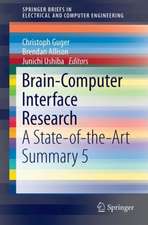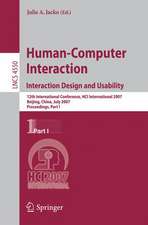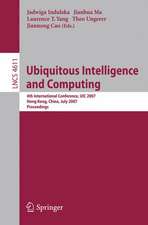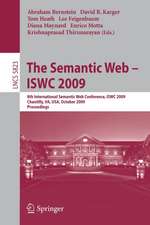HCI for Children with Disabilities: Human–Computer Interaction Series
Editat de Josefina Guerrero-Garcia, Juan Manuel González-Calleros, Jaime Muñoz-Arteaga, César A. Collazosen Limba Engleză Hardback – 12 mai 2017
In this book the authors present an HCI principle-based approach to develop applications to assist children with disabilities. Design knowledge related to developing complex solution for this audience is explained from an interaction design point of view. Different methodologies, models and cases studies are covered with the aim of helping practitioners to adopt any of the proposed techniques presented in this book.
HCI methodologies that adopt an agile strategy are presented, including novel techniques at different development steps, such as: board games, agile planning, agile implementation, method engineering. As this is a huge research field the authors do not just focus on a specific disability but test their methods in different contexts with excellent results. Readers of this book will find both a well-organized and structured set of methodologies and also material that has been tested and refined throughout years of research. Using detailed case studiesthe reader is guided towards specific solutions which will also provide insights into how to address related problems.
HCI methodologies that adopt an agile strategy are presented, including novel techniques at different development steps, such as: board games, agile planning, agile implementation, method engineering. As this is a huge research field the authors do not just focus on a specific disability but test their methods in different contexts with excellent results. Readers of this book will find both a well-organized and structured set of methodologies and also material that has been tested and refined throughout years of research. Using detailed case studiesthe reader is guided towards specific solutions which will also provide insights into how to address related problems.
| Toate formatele și edițiile | Preț | Express |
|---|---|---|
| Paperback (1) | 582.35 lei 38-44 zile | |
| Springer International Publishing – 9 sep 2018 | 582.35 lei 38-44 zile | |
| Hardback (1) | 667.75 lei 22-36 zile | |
| Springer International Publishing – 12 mai 2017 | 667.75 lei 22-36 zile |
Din seria Human–Computer Interaction Series
- 20%
 Preț: 655.85 lei
Preț: 655.85 lei - 20%
 Preț: 309.27 lei
Preț: 309.27 lei - 20%
 Preț: 375.54 lei
Preț: 375.54 lei - 20%
 Preț: 644.48 lei
Preț: 644.48 lei - 20%
 Preț: 664.44 lei
Preț: 664.44 lei - 20%
 Preț: 1164.84 lei
Preț: 1164.84 lei - 20%
 Preț: 817.55 lei
Preț: 817.55 lei - 20%
 Preț: 657.16 lei
Preț: 657.16 lei - 20%
 Preț: 645.31 lei
Preț: 645.31 lei - 20%
 Preț: 938.66 lei
Preț: 938.66 lei - 15%
 Preț: 658.05 lei
Preț: 658.05 lei - 20%
 Preț: 822.51 lei
Preț: 822.51 lei - 20%
 Preț: 654.21 lei
Preț: 654.21 lei - 20%
 Preț: 994.26 lei
Preț: 994.26 lei - 20%
 Preț: 1621.89 lei
Preț: 1621.89 lei - 20%
 Preț: 991.60 lei
Preț: 991.60 lei - 20%
 Preț: 783.46 lei
Preț: 783.46 lei - 20%
 Preț: 1175.42 lei
Preț: 1175.42 lei - 20%
 Preț: 659.97 lei
Preț: 659.97 lei - 20%
 Preț: 219.15 lei
Preț: 219.15 lei - 20%
 Preț: 334.86 lei
Preț: 334.86 lei - 20%
 Preț: 969.85 lei
Preț: 969.85 lei - 20%
 Preț: 642.19 lei
Preț: 642.19 lei - 20%
 Preț: 314.39 lei
Preț: 314.39 lei - 20%
 Preț: 661.14 lei
Preț: 661.14 lei - 20%
 Preț: 995.89 lei
Preț: 995.89 lei - 20%
 Preț: 752.59 lei
Preț: 752.59 lei - 20%
 Preț: 990.30 lei
Preț: 990.30 lei - 20%
 Preț: 990.12 lei
Preț: 990.12 lei - 20%
 Preț: 336.21 lei
Preț: 336.21 lei - 20%
 Preț: 334.71 lei
Preț: 334.71 lei - 20%
 Preț: 312.62 lei
Preț: 312.62 lei - 20%
 Preț: 994.92 lei
Preț: 994.92 lei - 20%
 Preț: 331.74 lei
Preț: 331.74 lei - 20%
 Preț: 646.80 lei
Preț: 646.80 lei - 20%
 Preț: 334.86 lei
Preț: 334.86 lei - 20%
 Preț: 994.40 lei
Preț: 994.40 lei - 20%
 Preț: 329.76 lei
Preț: 329.76 lei - 20%
 Preț: 332.24 lei
Preț: 332.24 lei - 20%
 Preț: 992.11 lei
Preț: 992.11 lei - 20%
 Preț: 650.40 lei
Preț: 650.40 lei - 20%
 Preț: 337.00 lei
Preț: 337.00 lei - 20%
 Preț: 332.39 lei
Preț: 332.39 lei - 20%
 Preț: 1279.86 lei
Preț: 1279.86 lei - 15%
 Preț: 636.12 lei
Preț: 636.12 lei - 20%
 Preț: 336.67 lei
Preț: 336.67 lei - 20%
 Preț: 1000.70 lei
Preț: 1000.70 lei - 20%
 Preț: 645.14 lei
Preț: 645.14 lei
Preț: 667.75 lei
Preț vechi: 834.69 lei
-20% Nou
Puncte Express: 1002
Preț estimativ în valută:
127.81€ • 138.88$ • 107.43£
127.81€ • 138.88$ • 107.43£
Carte disponibilă
Livrare economică 31 martie-14 aprilie
Preluare comenzi: 021 569.72.76
Specificații
ISBN-13: 9783319556659
ISBN-10: 3319556657
Pagini: 148
Ilustrații: XII, 148 p. 69 illus., 64 illus. in color.
Dimensiuni: 155 x 235 mm
Greutate: 1.03 kg
Ediția:1st ed. 2017
Editura: Springer International Publishing
Colecția Springer
Seria Human–Computer Interaction Series
Locul publicării:Cham, Switzerland
ISBN-10: 3319556657
Pagini: 148
Ilustrații: XII, 148 p. 69 illus., 64 illus. in color.
Dimensiuni: 155 x 235 mm
Greutate: 1.03 kg
Ediția:1st ed. 2017
Editura: Springer International Publishing
Colecția Springer
Seria Human–Computer Interaction Series
Locul publicării:Cham, Switzerland
Cuprins
Preface. -FlowagileXML: An HCI-Agile Methodology to Develop Interactive Systems for Children with Disabilities.- An Architectural Model to Design Graphical User Interfaces of Mobile Applications for Learning Problems in Basic Mathematics.- Extension of a User Model for Promoting the Development of Applications to Support Auditory Rehabilitation.- Interactive Systems Design oriented to Children with Special Needs.- Model-Driven Development of Interactive Environments for Occupational Therapy.- Towards the Design of Interactive Storytelling to support Literacy Teaching for Deaf Children.- Usability Study of Didactical Resources to Children with Down Syndrome.
Textul de pe ultima copertă
In this book the authors present an HCI principle-based approach for developing applications to assist children with disabilities. Design knowledge related to developing complex solutions for this audience is explained from an interaction design point of view. Different methodologies, models and cases studies are covered with the aim of helping practitioners to adopt any of the proposed techniques presented in this book.
HCI methodologies that adopt an agile strategy are presented, including novel techniques at different development steps, such as: board games, agile planning, agile implementation, method engineering. As this is a huge research field the authors do not just focus on a specific disability but test their methods in different contexts with excellent results.
Readers of this book will find a well-organised and structured set of methodologies and material that have been tested and refined throughout years of research. Using detailed case studies the reader is guided towards specific solutions which also provide insights into how to address related problems.
Readers of this book will find a well-organised and structured set of methodologies and material that have been tested and refined throughout years of research. Using detailed case studies the reader is guided towards specific solutions which also provide insights into how to address related problems.
Caracteristici
Provides explicit guidance on how to apply a methodological approach for developing applications for children with disabilities Explains how to apply different context of use make-believe to real life solutions Presents a new and efficient perspective for applying interaction design Includes supplementary material: sn.pub/extras








